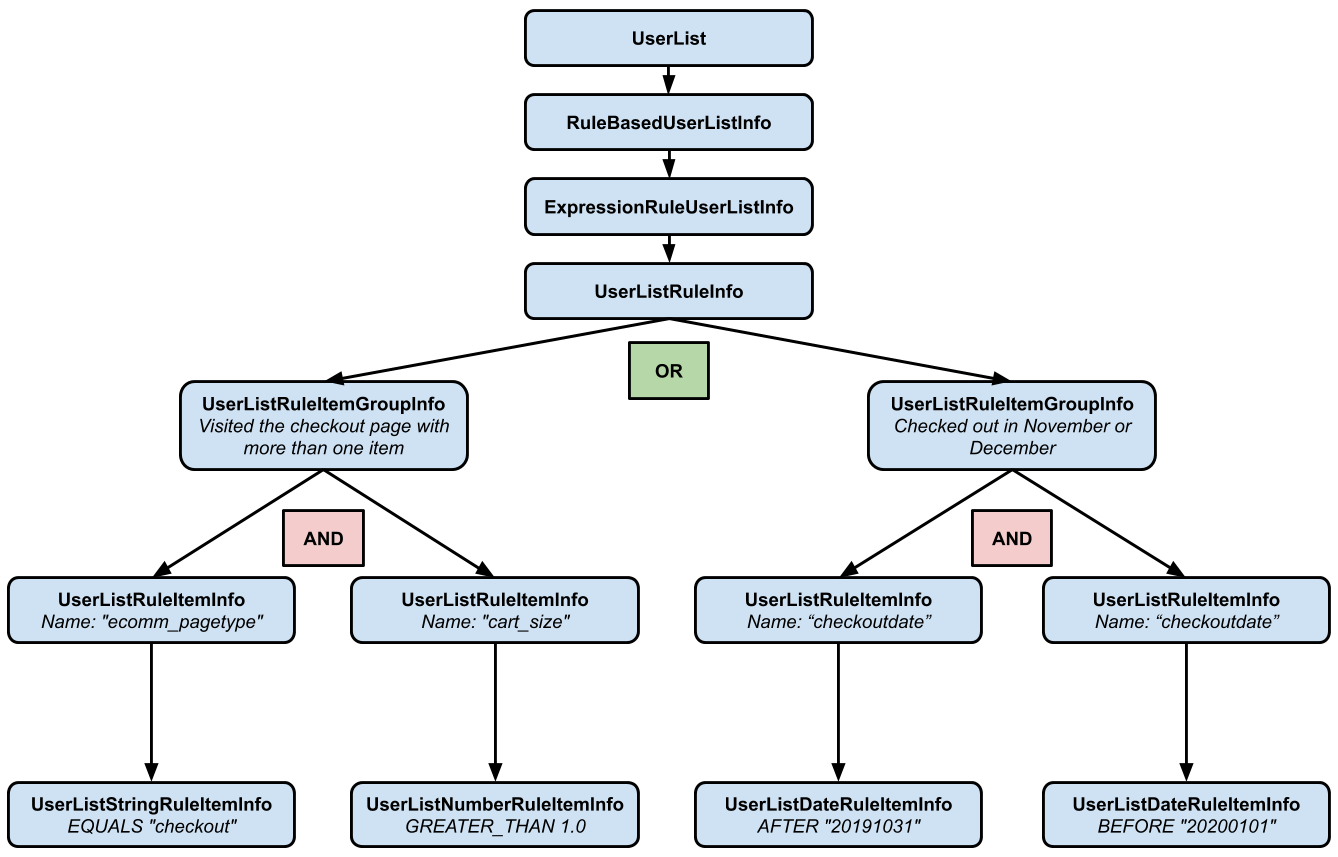情境
透過集合功能整理內容
你可以依據偏好儲存及分類內容。
假設您已在網站中設定多個自訂再行銷代碼參數,以便擷取下列使用者屬性:
event - 網站上的頁面類別,例如結帳、購物車等。cartsize - 使用者購物車中的商品數量。checkoutdate - 使用者退房的日期。只有在使用者實際完成購買時,才設定這個參數。
您希望向已將多項商品加入購物車並啟動結帳程序的使用者,放送更多曝光次數。此外,您也想找出在 11 月和 12 月期間完成購買的使用者,因為您打算在這段期間舉辦大型特賣活動。
您可以使用下列任一規則描述這組使用者:
- 造訪結帳頁面且購物車內有多個項目的使用者。
- 在 11 月或 12 月結帳的使用者。
如果使用者屬於第 1 類或第 2 類,您希望在特定廣告群組或廣告活動中,將出價提高 25%。
物件
請參閱以規則為準的使用者名單結構。在 Google Ads API 中,規則式名單會以 rule_based_user_list 表示。
下圖顯示完成後,這個用途的 rule_based_user_list 會是什麼樣子。

除非另有註明,否則本頁面中的內容是採用創用 CC 姓名標示 4.0 授權,程式碼範例則為阿帕契 2.0 授權。詳情請參閱《Google Developers 網站政策》。Java 是 Oracle 和/或其關聯企業的註冊商標。
上次更新時間:2025-09-05 (世界標準時間)。
[null,null,["上次更新時間:2025-09-05 (世界標準時間)。"],[[["\u003cp\u003eThis guide demonstrates how to target specific user segments for remarketing using rule-based user lists in Google Ads, based on custom parameters like event, cart size, and checkout date.\u003c/p\u003e\n"],["\u003cp\u003eIt focuses on creating rules to identify high-value users, such as those with large shopping carts who initiated checkout or those who purchased during specific months (November/December).\u003c/p\u003e\n"],["\u003cp\u003eBy implementing these rules, you can effectively increase bids for targeted ad campaigns to re-engage these valuable user segments, potentially leading to higher conversion rates.\u003c/p\u003e\n"],["\u003cp\u003eThe example illustrates how to structure a \u003ccode\u003erule_based_user_list\u003c/code\u003e to capture users fulfilling either of two criteria: having multiple items in their cart and reaching the checkout page, or having completed a purchase in November or December.\u003c/p\u003e\n"]]],[],null,["# Scenario\n\nSay you have a site where you've configured several custom remarketing tag\nparameters to capture the following attributes of users:\n\n- [`event`](//support.google.com/google-ads/answer/7305793) - The category of page on your site, such as checkout, cart, etc.\n- `cartsize` - The number of items in a user's shopping cart.\n- `checkoutdate` - The date on which a user checked out. You only set this parameter when a user has actually completed a purchase.\n\nYou're interested in showing more impressions to users who have placed multiple\nitems in their shopping carts and initiated the checkout process. You also want\nto find users who have made a purchase during November and December because you\nplan to have a big sale on your site during those months.\n\nYou can describe this set of users with either of the following rules:\n\n1. Users who visited the checkout page **and** had more than one item in their cart.\n2. Users who checked out during the months of November or December.\n\nIf a user falls into either category 1 or category 2, you want to increase your\nbids in specific ad groups or campaigns by 25%.\n\nObjects\n-------\n\nTake a look at the structure of a rule-based user list. A rule-based list is\nrepresented in the Google Ads API as a\n[`rule_based_user_list`](/google-ads/api/reference/rpc/v21/UserList#rule_based_user_list).\n\nThe following diagram shows what the\n[`rule_based_user_list`](/google-ads/api/reference/rpc/v21/UserList#rule_based_user_list) for this\nuse case will look like when we're done.\n\n\u003cbr /\u003e\n\n\u003cbr /\u003e"]]


